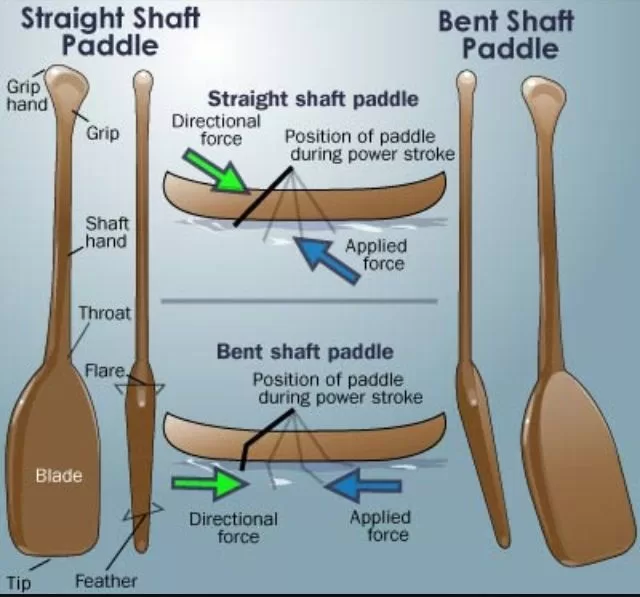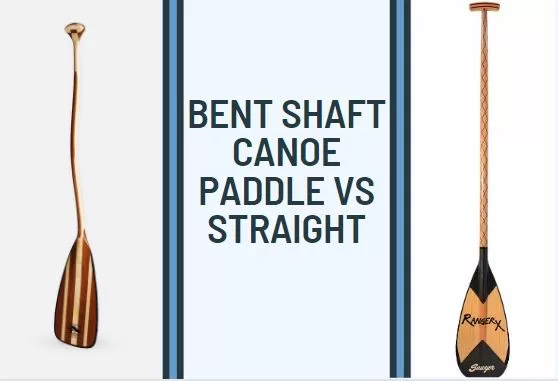Are you a canoeist looking to upgrade your paddle? Choosing between a straight or bent-shaft canoe paddle can be a difficult decision. With so many options available, it’s important to understand the benefits of each type.
A straight-shaft paddle is versatile and ideal for tight corners, while a bent-shaft paddle is more efficient for cruising and flatwater paddling. It reduces stress on your arms and back and keeps the blade vertical.
In this blog post, we’ll explore the differences between straight and bent-shaft canoe paddles and help you choose the right one for your paddling style and needs. Let’s dive in!
Key Takeaways On Straight Or Bent Shaft Canoe Paddle
Main difference Between Straight Vs Bent Shaft Canoe Paddles – Straight shaft paddles offer greater control and agility, while bent shaft paddles provide a more efficient forward stroke and reduce stress on the arms and back.
Which one is good – When choosing between a straight or bent shaft canoe paddle, consider the following: a straight shaft paddle offers versatility, is ideal for tight corners, and is a great all-around paddle. On the other hand, a bent shaft paddle is more efficient for calm water, reduces stress on the arms and back, and makes the forward stroke more efficient.

Straight Shaft Canoe Paddle
Straight-shaft canoe paddles are versatile and suitable for all-around paddling and maneuvering strokes. They offer greater control and maneuverability, making them ideal for navigating technical waters like narrow rivers or whitewater.
Solo paddlers or those who sit in the stern often prefer straight shaft paddles, as they act as the steering wheel for the canoe. While straight shaft paddles are not as efficient as bent shaft paddles in the forward stroke, they are still a good choice for shorter trips or those prioritizing control and versatility over speed.
- Pros
- Greater control and maneuverability
- Suitable for technical waters and all-around paddling versatility
- Often less expensive than bent shaft paddles
- Cons
- Less efficient in the forward stroke than bent shaft paddles
- It may require more effort for long-distance trips
Bent Shaft Canoe Paddle
A bent-shaft canoe paddle is designed to be more efficient and less tiring than a straight-shaft paddle. The blade of a bent shaft paddle is vertical in the water for more stroke, saving energy and reducing fatigue.
Bent shaft paddles are ideal for long-distance trips or those prioritizing speed over control. However, they are more expensive than straight shaft paddles and may require some adjustment in technique for those used to straight shaft paddles.
- Pros
- More efficient and less tiring than straight shaft paddles
- It provides as much as 20% more force in the water than straight-shaft paddles
- Ideal for long-distance trips or for those who prioritize speed over control
- Cons
- More expensive than straight shaft paddles
- It may require some adjustment in technique for those used to straight shaft paddles.
Do you know that a kayak paddle can be used for canoeing, and it put’s less strain on muscles and offers better average canoe speed. However, it is not recommended for narrow routes because it is lengthier than an average canoe paddle length. Since, it offer you a better control therefore, you can also go for canoeing in ocean for longer sessions using a kayak paddle.
Personal experience as a canoeist and primary difference
As a canoeist, the effectiveness and technique of the forward stroke distinguish a straight-shaft canoe paddle from one with a bent shaft.
Canoe Paddles with a straight shaft lifts water near the end of the stroke, which might cause the canoe to slow down. However, it allows for various strokes, swift twists, and hand modifications. A canoe paddle with a bent shaft, on the other hand, forces the water almost straight back, making the forward stroke more effective.
The forward stroke may become more effortless and efficient. It also improves ergonomics and lessens stress on the shoulders and wrists. Additionally, it makes all paddle strokes, including the rudder, simpler to execute.
Importance of choosing the right shaft of a canoe paddle
When choosing the right shaft of a canoe paddle, there are several factors to consider for a comfortable and efficient paddling experience:
- The paddle shaft’s design can impact the forward stroke’s efficiency. A bent-shaft paddle can make the forward stroke more efficient, while a straight-shaft paddle offers more versatility and allows for various strokes.
- The shape of the paddle shaft can affect ergonomics and reduce strain on the wrists and shoulders. Bent shaft paddles are often preferred for their ergonomic design.
- The type of paddle shaft can impact manoeuvrability, with straight-shaft paddles being considered the steering wheel for the canoe.
Which one is more compatible with canoeing strokes?
- Straight Shaft Canoe Paddle:
It is compatible with all-around paddling and maneuvering strokes and offers greater control and maneuverability, making it suitable for technical waters like narrow rivers or whitewater.
It is preferred by solo paddlers or those in the stern (back of the canoe) as they act as the steering wheel for the canoe.
- Bent Shaft Canoe Paddle:
It is compatible with various canoeing strokes and provides a more efficient forward stroke because the blade is kept vertical for a longer portion of the stroke.
It reduces stress on the arms and back, making it more comfortable for long-distance trips.
Do you know How Long Does It Take To Canoe 10 Miles?
It takes 3.5 hours to canoe 10 miles if you maintain an average speed of 3 mph or 2.6 knots in normal water conditions. But, there are other factors as well, such as canoe material. it’s dimensions. paddling experience, overall weight and water conditions.
Which one is right for me as per different conditions & waterways?
When deciding between a straight or bent shaft canoe paddle, it’s important to consider the specific conditions and waterways you’ll be paddling in.
A bent-shaft paddle can offer greater efficiency by pushing water straight back for long-distance or open-water paddling. However, if you’ll be navigating technical waters that require various strokes, a straight-shaft paddle provides more versatility.
If you’re concerned about wrist and shoulder strain, a bent shaft paddle’s ergonomic design may be more suitable. A straight-shaft paddle also allows for quick turns and adjustments for maneuverability/steering the canoe in narrow or winding waterways.
FAQs – Straight or Bent Shaft Canoe Paddle
Which paddle type is better for beginners: straight or bent shaft?
A straight-shaft paddle is typically advised for beginners. It is easier to control and lighter than a paddle with a bent shaft. Straight-shaft paddles are typically less expensive as well. However, it’s essential to try both and select the one that feels most comfortable to you.
Are there any specific paddling techniques that work better with a particular paddle type?
Paddling techniques differ between a straight-shaft paddle and a bent-shaft paddle. A straight shaft paddle involves a “pull back” motion and is versatile for various strokes, tight corners, and agility around obstructions. A bent shaft paddle involves a “push down” motion, is more efficient for cruising across calm water, and reduces stress on the arms and back.
Are there any myths or misconceptions about one type of paddle over the other?
There are myths and misconceptions about paddle types. Some believe straight-shaft paddles are always better for beginners, while others think bent-shaft paddles are only for advanced paddlers. However, the truth is that the choice depends on personal preference and the type of paddling. Bent shaft paddles can be efficient and versatile, while straight shaft paddles can offer control.
How can I determine which paddle type best suits my skill level and current situation?
Consider the waterways, paddling style, and skill level to determine the best paddle type. Straight shaft paddles are versatile for tight corners, while bent shaft paddles are efficient for calm water.

Passionate freelance writer and certified boat captain, Sam brings his expertise to this pedal boating & Canoeing blog. With a knack for captivating storytelling and in-depth knowledge of boating regulations, he’s here to make your boating experience even more enjoyable and informed.
